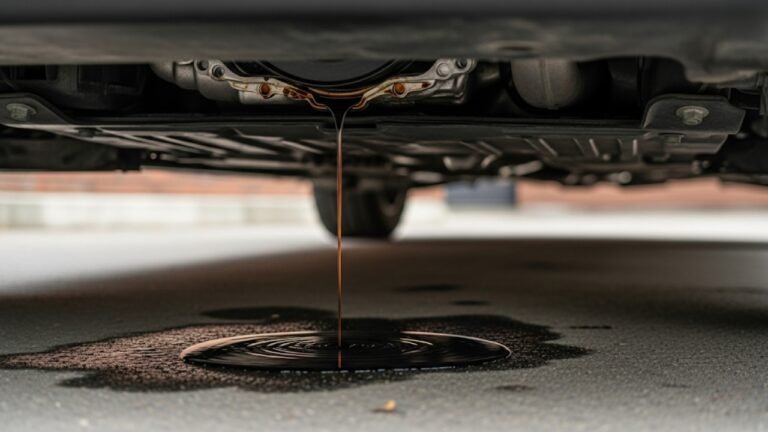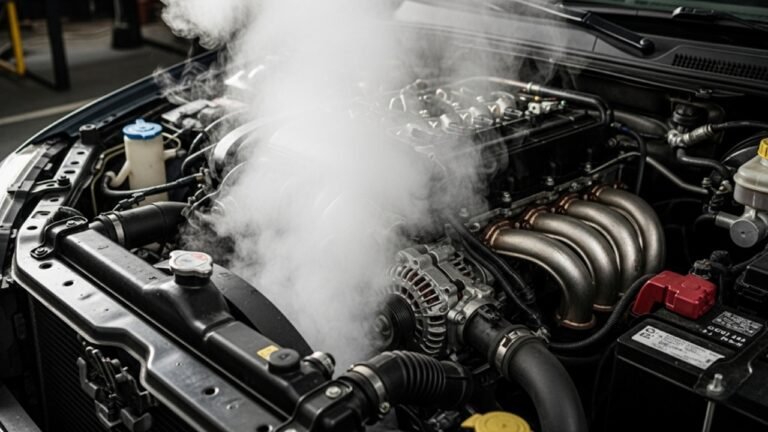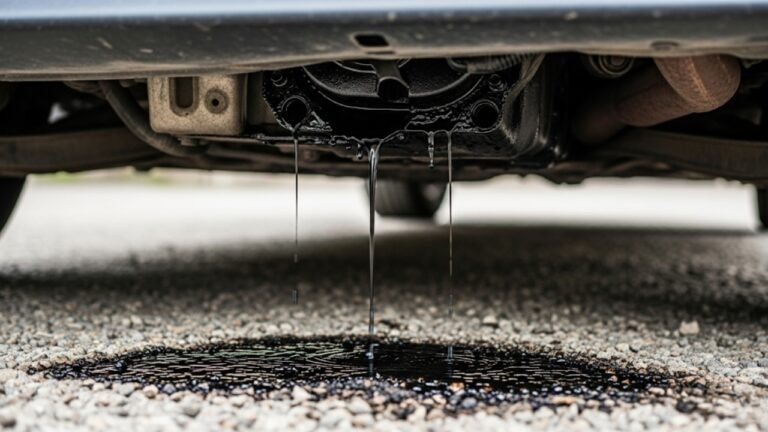Can I Put a Whole Quart of Oil in My Car?

Ever stood in front of your car’s engine with a bottle of motor oil in hand, wondering, “Can I put a whole quart of oil in my car?” Trust me, you’re not alone. I’ve been there, too—grimy fingers, checking the dipstick, second-guessing myself. It seems like a simple thing, right? You’re topping off oil, and you’ve got a quart. So why not just pour the whole thing in?
Well, it’s not always that straightforward. Just like you wouldn’t overfill your coffee mug and risk spilling hot java on your hand, overfilling your engine with oil can lead to messes—some of them costly.
In this article, I’ll walk you through the real answer to that question. We’ll cover engine basics, oil capacity, risks of overfilling, and how to know when enough is enough. Whether you’re new to cars or just brushing up, I’ll keep things simple, real, and practical.
In This Article
- 1 Understanding Engine Oil: Why It’s Not Just “Extra Fluid”
- 2 How Much Oil Does Your Car Actually Need?
- 3 So, Can I Put a Whole Quart of Oil in My Car?
- 4 When Adding a Quart Is the Right Move
- 5 What Happens If I Overfill My Oil? (Spoiler: It’s Not Good)
- 6 Oil Changes vs Topping Off: What’s the Difference?
- 7 How to Check Oil Like a Pro (Even if You’re Not One)
- 8 Still Wondering “Can I Put a Whole Quart of Oil in My Car?” Let’s Recap
- 9 When Not to Add a Whole Quart: Common Mistakes to Avoid
- 10 Signs Your Car Might Need a Whole Quart of Oil
- 11 The Emotional Cost of Engine Trouble
- 12 Best Practices: Keeping Your Engine Happy
- 13 FAQs: Can I Put a Whole Quart of Oil in My Car?
- 13.1 1. Is it OK to add a full quart of oil to my engine?
- 13.2 2. Can too much oil damage my engine?
- 13.3 3. How do I know how much oil to add?
- 13.4 4. Can I mix oil brands when topping off?
- 13.5 5. Do I need to warm the engine before checking the oil?
- 13.6 6. What if I accidentally added too much oil?
- 13.7 7. How often should I check my oil level?
- 13.8 8. Is it cheaper to top off oil instead of changing it?
- 14 Final Thoughts: It’s Not Just a Quart—It’s Confidence
Understanding Engine Oil: Why It’s Not Just “Extra Fluid”

Engine oil is like your body’s blood. It lubricates, cools, and protects the engine from wear and tear. Without it, parts would grind against each other like rusty gears. But here’s the kicker—too much oil can cause damage, too. Just like too little.
Most cars hold between 4 to 6 quarts of oil. But that doesn’t mean every time your dipstick is low, you should toss in a whole quart. Your dipstick gives you a range, and that range matters. Each notch or space between marks is usually about half a quart.
Here’s a simple metaphor: Think of your engine like baking a cake. You wouldn’t double the oil in a recipe just because you can, right? Same goes here. There’s a sweet spot—and too much or too little ruins the balance.
How Much Oil Does Your Car Actually Need?
This is the question most people don’t ask—but it’s the one that matters most.
Each vehicle has a specific oil capacity. It’s not the same across the board. Your owner’s manual will tell you exactly how much oil is needed after a full drain and refill. But if you’re just topping off, you need to check the dipstick, not just pour in a full bottle.
Here’s a quick reference:
| Engine Size | Approximate Oil Capacity | Notes |
|---|---|---|
| 4-cylinder | 4.0–5.0 quarts | Most common in compact cars |
| 6-cylinder | 5.0–6.0 quarts | Found in midsize sedans and SUVs |
| 8-cylinder | 6.0–8.0 quarts | Common in trucks and performance cars |
If your dipstick shows oil at or near the low mark, you’re probably down about half a quart to a quart. That’s when people reach for a bottle and wonder: Should I pour in the whole thing?
Let’s break that down.
So, Can I Put a Whole Quart of Oil in My Car?
Here’s the short answer: It depends.
If your dipstick is below the low mark, then yes, adding a whole quart is usually safe. But if you’re somewhere between low and full, pouring in a full quart could overfill your engine.
And that’s where problems begin.
When too much oil enters the engine, it can cause the oil to foam. This reduces lubrication, increases pressure, and can cause seals to leak or even blow. In the worst case, it can damage the catalytic converter or oxygen sensors.
Let me share a quick story: A friend of mine once topped off his SUV with a full quart, not checking the dipstick first. He ended up with white smoke pouring from the exhaust, and a $400 repair bill. All for one extra cup of oil.
So, the golden rule is this: Always check your dipstick before adding oil. Pour slowly. Check again. You can always add more—but you can’t take it out easily.
When Adding a Quart Is the Right Move
There are situations where adding a full quart is not only okay—it’s necessary.
These include:
-
After a long road trip, when your engine has burned more oil than usual.
-
Older cars that naturally consume oil due to wear.
-
If the dipstick is bone dry, or you get an oil pressure warning light.
-
After an oil change, when you’re refilling the engine completely.
Still, the dipstick is your best friend here. If you’re well below the low mark, then yes, it’s usually safe to add a whole quart of oil.
Pro Tip: If you’re unsure, start with half a quart, wait a minute, and recheck the dipstick. It’s worth the patience.
What Happens If I Overfill My Oil? (Spoiler: It’s Not Good)
Think of oil overfilling like overwatering a plant. At first, it seems harmless. But too much, and the roots start to rot.
Overfilling oil causes increased pressure in the crankcase. That pressure forces oil into places it shouldn’t go—like spark plug tubes, or past seals. The result? Oil leaks, smoke, poor performance, and in extreme cases, engine failure.
Symptoms of too much oil include:
-
Blue or white smoke from the exhaust
-
Burning oil smell
-
Rough idling or stalling
-
Oil spots under the car
It’s not instant death for your engine, but it’s definitely a stress test it didn’t ask for. If you’ve added too much oil by mistake, don’t panic. You can use an oil extractor to pull some out—or visit a mechanic.
Just like cooking, it’s easier to add than to take away.
Oil Changes vs Topping Off: What’s the Difference?
A lot of people confuse adding a quart of oil with doing a full oil change. They’re not the same thing.
Topping off means adding oil to bring the level back up. You’re not replacing the old oil—you’re just supplementing it. An oil change, on the other hand, means draining all the old oil, replacing the filter, and filling the engine with fresh oil.
Here’s a quick comparison:
| Task | What You Do | When to Do It |
|---|---|---|
| Topping Off | Add a small amount (like a quart) | When dipstick is low |
| Oil Change | Drain all old oil and refill | Every 3,000 to 7,500 miles depending on your car |
Topping off too often without changing oil can lead to dirty, sludgy oil, which reduces engine life. So yes, you can put in a quart if needed—but don’t skip regular oil changes thinking you’re good to go.
How to Check Oil Like a Pro (Even if You’re Not One)
If you’re not sure how to check your oil, don’t feel bad. Most people were never shown how. Here’s the easy version:
-
Park on level ground and turn the engine off. Wait 5–10 minutes.
-
Open the hood and pull out the dipstick.
-
Wipe it clean with a rag, then reinsert it fully.
-
Pull it out again and look at the level between the “Low” and “Full” marks.
Each notch usually represents half a quart. So if you’re halfway between marks, you probably need a quarter quart. If you’re near or below the low mark, it’s safe to add up to a quart—but never blindly pour in the full bottle without checking first.
Still Wondering “Can I Put a Whole Quart of Oil in My Car?” Let’s Recap
Before we move on to FAQs and advanced insights, here’s what we’ve covered:
-
Engine oil is essential—but the right amount matters.
-
Most cars take 4 to 6 quarts total, and a quart is a significant amount.
-
If you’re very low on oil, adding a quart is often safe and smart.
-
If you’re only a little low, adding a full quart might overfill the engine.
-
Always check the dipstick before adding oil.
-
Overfilling can cause real damage—from leaks to engine failure.
When Not to Add a Whole Quart: Common Mistakes to Avoid
Let’s get real for a moment. We’ve all been tempted to just “top it off and go.” But sometimes, that urge does more harm than good. So when shouldn’t you add a whole quart of oil?
Here are common scenarios:
-
You just did an oil change and think your engine “sounds off”—don’t assume it needs more oil.
-
The dipstick level is slightly under full. Topping off with a whole quart here is too much.
-
You’re using the wrong type or weight of oil. Mixing different viscosities isn’t ideal.
-
You haven’t let the engine cool down before checking the dipstick. Oil expands when hot, giving false readings.
If any of these sound familiar, take a breath. Double-check before you act. Rushing to pour in a quart can be like throwing water on a fire without knowing the cause. Your best tool here is patience and observation.
Signs Your Car Might Need a Whole Quart of Oil
Alright, let’s break it down simply. These are the signs that usually mean adding a whole quart is safe—or even urgent:
-
Low oil light or warning comes on
-
Dipstick is completely dry
-
You hear a ticking noise from the engine when you start the car
-
You’ve driven a lot of miles since your last check or oil change
-
You notice a slight burning smell under the hood
Each of these signals means your engine’s thirsting for oil. In these cases, adding a whole quart of the correct type of oil might just save you from a much bigger problem.
Still, even if you’re 90% sure, take that extra moment to check the dipstick. That last 10% can make a huge difference.
The Emotional Cost of Engine Trouble
Let’s be honest—it’s not just about the car. It’s about how you feel when something goes wrong.
That sinking feeling when the dashboard light comes on. That knot in your stomach when your car jerks unexpectedly. I remember once pulling off the highway at midnight, oil light flashing, heart pounding. I was tired, scared, and just wanted to get home.
These are the moments where basic knowledge, like knowing whether to add a quart of oil, makes all the difference. It’s more than maintenance—it’s peace of mind.
So, if you’re asking, “Can I put a whole quart of oil in my car?”—you’re really asking, “Can I keep my car safe without risking damage?”
And that answer is: Yes, if you do it the right way.
Best Practices: Keeping Your Engine Happy
Let’s turn this into a short checklist you can use next time you’re under the hood.
- Check the dipstick before adding oil
- If you’re well below the low mark, add a whole quart
- Use the right viscosity and oil type
- Avoid mixing brands or oil types unless necessary
- Don’t top off unnecessarily after an oil change
- Watch for symptoms of overfilling, like smoke or rough idle
- Record your oil checks in a log (yes, seriously—it helps)
Doing this helps you build a trusting relationship with your vehicle. Think of it like checking in with an old friend: it doesn’t take long, and it saves trouble down the road.
FAQs: Can I Put a Whole Quart of Oil in My Car?
1. Is it OK to add a full quart of oil to my engine?
Yes—if your dipstick shows you’re low enough. A whole quart is typically safe when you’re near or below the “Low” mark. Just don’t overfill.
2. Can too much oil damage my engine?
Absolutely. Too much oil creates pressure, causes foam, and may damage seals or internal parts.
3. How do I know how much oil to add?
Check your dipstick. The space between the “Low” and “Full” usually represents 1 quart. Halfway down means you need half a quart.
4. Can I mix oil brands when topping off?
While not ideal, yes—you can mix brands if it’s the same viscosity (like 5W-30). Just avoid doing it often.
5. Do I need to warm the engine before checking the oil?
Let the engine cool for 5–10 minutes after turning it off. That gives oil time to settle and gives an accurate reading.
6. What if I accidentally added too much oil?
If you’ve gone a little over the “Full” mark, you’re probably okay. But if it’s significantly over, use an oil extractor or see a mechanic ASAP.
7. How often should I check my oil level?
At least once a month or before long trips. Older cars may need more frequent checks.
8. Is it cheaper to top off oil instead of changing it?
Maybe short-term, but long-term, dirty oil builds sludge and shortens engine life. Topping off isn’t a replacement for regular oil changes.
Final Thoughts: It’s Not Just a Quart—It’s Confidence
So, now that we’ve taken this ride together, what’s the final verdict?
Can I put a whole quart of oil in my car?
Yes—when the engine needs it. But blindly adding without checking can lead to more harm than good.
Cars, like people, send subtle signals. Listening to them means fewer breakdowns, fewer bills, and way less stress. It also makes you a more confident car owner.
Keep a quart of the right oil in your trunk. Keep an eye on the dipstick. And always remember: it’s easier to add than to remove.
Thanks for sticking with me on this journey. If you’ve learned something—or smiled along the way—then I’ve done my job. Drive safe, check your oil, and treat your car like it’s a part of your family.






